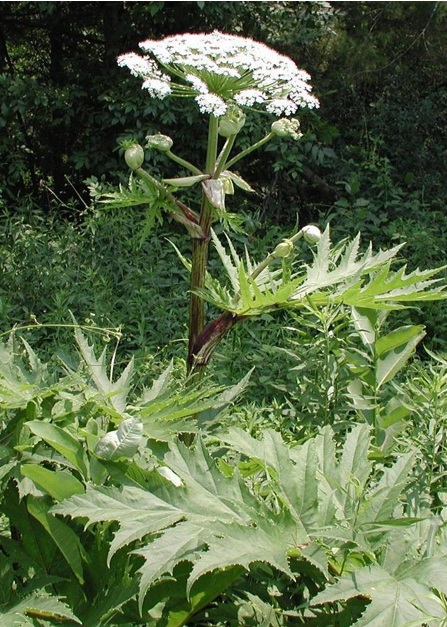There has been a lot of coverage both in the press and on the radio recently about the evasive weed Giant Hogweed.
See for example this story from the Yorkshire Press entitled Giant hogweed Leeds: Investigation launched on Cookridge estate after resident raises 'danger' concerns about plants.
Although an impressive sight when fully grown, Giant Hogweed is invasive and potentially harmful. Chemicals in the sap can cause photodermatitis or photosensitivity, where the skin becomes very sensitive to sunlight and may suffer blistering, pigmentation and long-lasting scars.

Giant Hogweed
I myself have come across this plant on a number of occasions and I am generally very cautions when working by it. I first came across this plant back in the 1970s whilst working for Birmingham City Council, where it was found growing in one of the city’s parks that I was working in.
Giant Hogweed (Heracleum mantegazzianum) is a close relative of cow parsley originally from Southern Russia and Georgia. It can reach over 3m (10ft) in height. Although this striking plant can be attractive in certain situations, most gardeners will want to eradicate it, as it is potentially invasive and the sap can cause severe skin burns. It is widely distributed in the wild and poses a serious risk to people who are unaware of its potential for harm.
Giant Hogweed is one of many evasive weeds that come under legislation. There are a number of different regulations at both national and European level in place to help protect our environment from invasive non-native plants.
In Scotland the Wildlife and Natural Environment Act (Scotland) 2011 is now in force making it illegal to plant any non-native plant in the wild in Scotland.
Elsewhere in the UK it is an offence to plant or cause to grow in the wild plants listed on Schedule 9 of the Wildlife and Countryside Act (1981). In April 2014 a ban on sale of five of the worst invasive water plants in the UK came into force - see list here.
EU Regulation on Invasive Alien Species lists 36 plants. This legislation still applies in the UK. These plants should not be planted or caused to grow in the wild but in addition are banned from sale and gardeners possessing them should undertake measures to control them There is always a risk when disposing of invasive weeds that you may inadvertently spread them further.
Himalayan balsam, Giant Hogweed, and Japanese knotweed: control with weedkiller or dig up and burn on site. These weeds are regarded as 'controlled waste' under the Environmental Protection Act (Duty of Care) Regulations so if taken off site can only be disposed of in registered landfill sites. Check with your local council for your nearest suitable site. Do not put in your normal green waste or household waste.
Other invasive plants on the EU list: control with weedkiller or dig up and burn on site. Alternatively, DEFRA advise they can be disposed of as normal green waste through local recycling.
Note that the movement of invasive non-native plants is only permitted as part of responsible disposal. Never dump invasive plants or any garden plant in the wild or at the side of the road.
As for treatment if you have come into contact and suffered skin blistering from touching the Giant Hogweed, it is best to get medical advice and go and see a doctor as soon as possible.